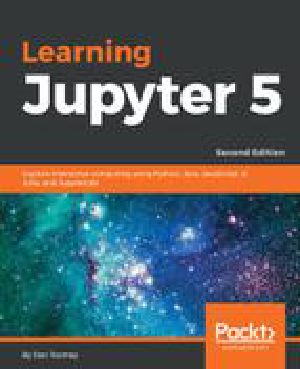Learning Jupyter 5 · 2nd Edition

- Authors
- Toomey, Dan
- Publisher
- Packt Publishing - ebooks Account
- Tags
- python , programming
- Date
- 2018-11-09T00:00:00+00:00
- Size
- 10.59 MB
- Lang
- en
Learn how to write code, mathematics, graphics, and output, all in a single
document, as well as in a web browser using Project Jupyter About This Book
Learn to write, execute, and comment your live code and formulae all under one
roof using this unique guide This one-stop solution on Project Jupyter will
teach you everything you need to know to perform scientific computation with
ease This easy-to-follow, highly practical guide lets you forget your worries
in scientific application development by leveraging big data tools such as
Apache Spark, Python, R etc Who This Book Is For This book caters to all
developers, students, or educators who want to execute code, see output, and
comment all in the same document, in the browser. Data science professionals
will also find this book very useful to perform technical and scientific
computing in a graphical, agile manner. What You Will Learn Install and run
the Jupyter Notebook system on your machine Implement programming languages
such as R, Python, Julia, and JavaScript with Jupyter Notebook Use interactive
widgets to manipulate and visualize data in real time Start sharing your
Notebook with colleagues Invite your colleagues to work with you in the same
Notebook Organize your Notebook using Jupyter namespaces Access big data in
Jupyter In Detail Jupyter Notebook is a web-based environment that enables
interactive computing in notebook documents. It allows you to create and share
documents that contain live code, equations, visualizations, and explanatory
text. The Jupyter Notebook system is extensively used in domains such as data
cleaning and transformation, numerical simulation, statistical modeling,
machine learning, and much more. This book starts with a detailed overview of
the Jupyter Notebook system and its installation in different environments.
Next we'll help you will learn to integrate Jupyter system with different
programming languages such as R, Python, JavaScript, and Julia and explore the
various versions and packages that are compatible with the Notebook system.
Moving ahead, you master interactive widgets, namespaces, and working with
Jupyter in a multiuser mode. Towards the end, you will use Jupyter with a big
data set and will apply all the functionalities learned throughout the book.
Style and approach This comprehensive practical guide will teach you how to
work with the Jupyter Notebook system. It demonstrates the integration of
various programming languages with Jupyter Notebook through hands-on examples
in every chapter."